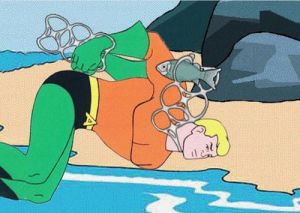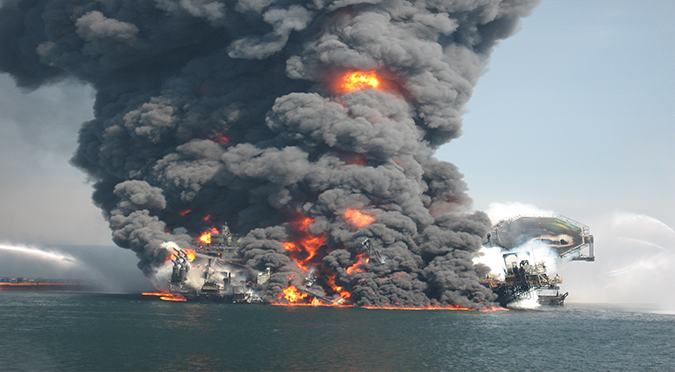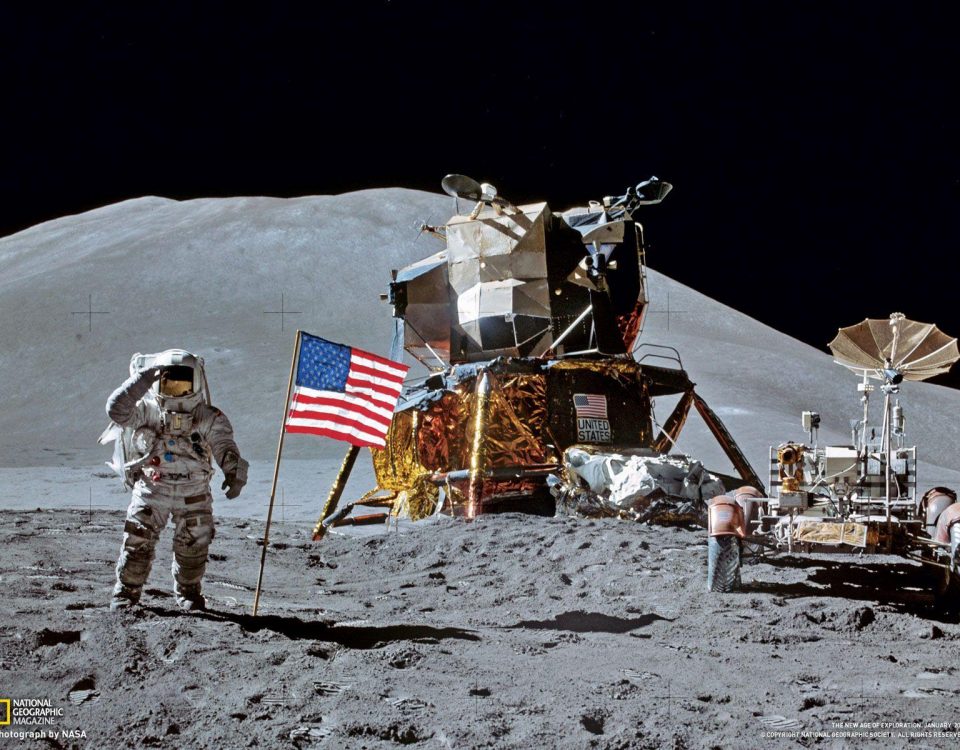
ENRON
April 1, 2014
The War of … Jenkins’ Ear?!
May 21, 2014CLICK HERE TO CHECK OUT THE ALL NEW EARTH WEEK 2020 PODCAST EPISODE!
Earth Day 2014 – April 22nd.

Earth: an M-class planet inhabited by a savage industrial race of sentient bi-pedal organisms with an insatiable need to consume and destroy their own environment. Proceed with caution.
“When all the trees have been cut down, when all the animals have been hunted, when all the waters are polluted, when all the air is unsafe to breathe, only then will you discover you cannot eat money.” – Cree Indian Prophecy
The human species is an extraordinary creature: Resourceful, innovative, and capable of surviving under extreme conditions against unbelievable odds. Unfortunately, we also don’t have the best track record. Point being, if there really are extraterrestrial neighbors spying us, we’ve given them plenty of reason to quarantine us from the rest of the galaxy.
 Since the Industrial Age, we humans have been pushing our world to the brink. Much like the dangers of smoking, people are only now starting to realize that cutting down entire rain forests, dumping toxic waste into the ocean, and pumping tons of chemicals into the air is actually hazardous to our own health! Between climate change, our dwindling (un-renewable) resources, dozens of endangered species, and mass pollution problems, you’d think we would’ve gotten the memo by now. (Spoiler: we haven’t)
Since the Industrial Age, we humans have been pushing our world to the brink. Much like the dangers of smoking, people are only now starting to realize that cutting down entire rain forests, dumping toxic waste into the ocean, and pumping tons of chemicals into the air is actually hazardous to our own health! Between climate change, our dwindling (un-renewable) resources, dozens of endangered species, and mass pollution problems, you’d think we would’ve gotten the memo by now. (Spoiler: we haven’t)
In honor of our one and only home planet, Earth, here’s a list of some of the ‘creative’ ways we’ve shown our respect and appreciation for the interdependent web of existence in which we are all apart… For this list, I’ll be focusing on man-made catastrophes rather than mother nature’s occasional temper tantrums, with one notable exception.
—- The following are thirteen Eco-Disasters that should never have come to pass:
13. The Great Pacific Garbage Patch
The Great Pacific Garbage Patch sounds like a noble achievement, it’s almost as though we’re proud of our monumental ‘accomplishments’ in the field of polluting every last inch of our planet, you know like a tourist destination, the 9th Wonder of the World and all that…
This Not-so-Great Pacific Patch of Garbage is described as a vortex of trash, plastic particles, and various debris swirling around in the northern Pacific Ocean. It’s less of an island of garbage, and more of a well-mixed soup of plastic bags and soda cans.
 Just to be clear, it’s not actually one specific patch of garbage – it’s primarily made up of two gigantic masses of swirling oceanic litter which feed off each other: the Western Garbage Patch off the coast of Japan, and the Easter Garbage Patch off the coast of California, each interconnected by the current of the Subtropical Convergence Zone north of Hawaii.
Just to be clear, it’s not actually one specific patch of garbage – it’s primarily made up of two gigantic masses of swirling oceanic litter which feed off each other: the Western Garbage Patch off the coast of Japan, and the Easter Garbage Patch off the coast of California, each interconnected by the current of the Subtropical Convergence Zone north of Hawaii.
It’s also not unique to the Pacific Ocean, but just happens to be the greatest concentration. The volume of plastic debris has increased 100 fold over the past forty years! What’s worse is 80% of that is from land, not ships, approximately 65% of which is “consumer used plastics that have not been disposed of properly,” (Algalita Marine Research Institute) meaning that this isn’t one of those problems caused by dastardly corporate greed, but rather because Billy Bob on the beach is just too dang lazy to dispose of his waste in a specified container.

Not ok Billy Bob, not ok.
It’s one thing to not recycle, but if you’re dumping your $#&% on the beach and letting the tide clean up your mess – You Are *THE REASON* that “Idiocracy” comes to fruition!

12. The Aral ‘Sea’
What was once a thriving sea in the 1960’s was soon reduced to a deserted graveyard of ships – courtesy of Soviet Russia’s irrigation projects.

The Aral Sea – Before and After (1989-2008)
The Aral Sea was once the fourth largest lake in the world! A thriving oasis between the harsh climates of Kazakhstan, Uzbekistan, and Turkmenistan. The lake was fed by two rivers which drained rainwater and snow melt from faraway mountains. Well that was before the Soviet Union came to town…
The Russians diverted two rivers: the Syr Darya and the Amu Darya, in order to grow cotton and other crops in an arid environment, and in so doing caused irreversible damage to the surrounding ecosystem.
The lake drastically dried up over the course of the next two decades. What was left of it became polluted with pesticides and fertilizer, killing the remaining fish, causing fishermen to go out of business, leading to the collapse of entire communities over night. The salty water degraded the soil, and to top it off, the contaminated dust from the exposed lake bed became a public health hazard. Without the moderating effects of the lake, the winters became colder, while the summers were hotter and even drier than ever.
A dam project was initiated in 2005, but it was too little too late, the damage had been done.
11. Oil Spills: Exxon Valdez – 1989 (Canada) / Amoco Cadiz – 1978 (France)
 In 1989, (off the cost of Alaska) an oil tanker (the Exxon Valdez) ran aground on the Bligh reef resulting in one of the largest crude oil catastrophes of all time!
In 1989, (off the cost of Alaska) an oil tanker (the Exxon Valdez) ran aground on the Bligh reef resulting in one of the largest crude oil catastrophes of all time!
The 30,000 ton US cargo ship dumped a total of 750,000 barrels and approximately 10.8 million gallons of murky black fuel into the ocean.
The immediate effects included the eradication of between 100,000 to as many as 250,000 sea birds as well as the deaths of 22 Orcas, 247 Bald Eagles, 300 Harbor Seals, and 2,800 Sea Otters, along with countless salmon and herring.
Although the incident led to an entire overhaul of the system, and political reforms (including the Oil Pollution Act of 1990), it would not be the last, nor the worst to come.
25 years later, the effects are still being felt throughout the region…
Poor Free Willy 🙁
……………………
But as terrible as Exxon Valdez was, it wasn’t quite as bad as the Amoco Cadiz Oil Spill of ’78…
 Due to a severe winter storm, the ship broke in half, and dumped 69 million gallons of Iranian and Arabian oil into the English Channel (off the coast of France) in 1978 – more slime than the Ghostbusters ever had to deal with!
Due to a severe winter storm, the ship broke in half, and dumped 69 million gallons of Iranian and Arabian oil into the English Channel (off the coast of France) in 1978 – more slime than the Ghostbusters ever had to deal with!
The cleanup efforts were hindered every step of the way. The entire incident was estimated to have caused damages around $250 million to tourism and amenities, but the long term ecological effects are (per usual) far more costly. The worst part is that these two terrible incidents were just the tip of the iceberg: There have been over 125 major oil spills in the last hundred years!

Dr. Robotnik up to his old tricks again…
10. Jilin Chemical Plant Explosion – 2005 (China)

On November 13, 2005, the Petrochemical Plant of Jilin, China erupted in a series of explosions. Windows shattered 200 meters away from the powerful blasts. Poisonous plumes of yellow fog dispersed over the province. One hour later: Six dead, dozens of injured workers, thousands displaced in evacuations, and 100 tons of pollutants contaminated the Songhua River with trace amounts of nitrobenzene, a compound attributed to causing leukemia.

9. Deforestation of the Amazon Rainforest

South America’s Amazon Rainforest is home to 30% of the world’s plant and animal species, and is vital to the stability of Earth’s ecosystem. Since 1970, a swath the size of Texas has been eliminated between agricultural endeavors, urban development, and illegal logging. Furthermore, if the current rate of deforestation continues, it’s estimated that the Amazon will shrink by 40% over the next twenty years. There’s approximately 3,344,297 km² left, and dropping rapidly.

No wonder Poison Ivy went all eco-terrorist!
8. Love Canal – 1978
This may sound like a romantic fair ride, but I assure you, this was far more sinister.
Love Canal was a small community in Niagara Falls, New York that had fallen on hard times. William T. Love had the canal built by immigrant workers as part of a massive renovation project that would connect the Niagara River to Lake Ontario. His vision was never realized when he ran out of funds and the project was abandoned leaving a one mile long trench. The site eventually became a popular place for children to swim in the summer and ski in the winter.
 Throughout the 40’s and 50’s the site had been a common dumping ground for all manner of toxic waste, thanks to the super negligent Hooker Chemical Company. If that wasn’t bad enough on it’s own, Hooker Chemical not only covered up this heavily polluted canal with layers of soil, but then in 1953, they sold the dumping site to the Niagara Falls School Board?! … for One Dollar!?
Throughout the 40’s and 50’s the site had been a common dumping ground for all manner of toxic waste, thanks to the super negligent Hooker Chemical Company. If that wasn’t bad enough on it’s own, Hooker Chemical not only covered up this heavily polluted canal with layers of soil, but then in 1953, they sold the dumping site to the Niagara Falls School Board?! … for One Dollar!?
So to recap: this over-the-top evil corporation not only tried to cover up their nefarious actions (i.e. dumping chemicals and literally paving over it), they then sold their toxic waste dump to a school board. I repeat – a school board!
When construction of a new *Elementary School* started on the property, during excavation, the workers discovered two large dump sites filled with chemical drums. The architect expressed his concern, because you know, it would be poor policy to build a foundation atop potentially hazardous materials… maybe not the best place for a school?!
In response, they simply moved the school 80 feet north. 400 children attended the Elementary in 1955, and a second school opened six blocks away. That same year, the ground partially caved in exposing chemical drums – near the a playground!

The real problems began to arise when new neighborhoods began to spring up over the contaminated land and construction of a sewer system began. During housing development, the sealed chemicals began to leak into the sewage system – because of course they did!
In 1962, heavy rain released a flood of oily chemicals seeping up from below. Birth defects, miscarriages, asthma, epilepsy, cancer, and other health related anomalies began to show up over the next decade, but it took a while before the people put two and two together and realized that they were living on 21,000 tons of toxic waste!

What could go wrong?
The Hooker Chemical Company and the U.S. government remained silent to protesters for years, until the EPA (Environmental Protection Agency) stepped in and led a full-scale investigation. Eckhardt C. Beck reported, “I visited the canal area at that time. Corroding waste-disposal drums could be seen breaking up through the grounds of backyards. Trees and gardens were turning black and dying. One entire swimming pool had been popped up from its foundation, afloat now on a small sea of chemicals. Puddles of noxious substances were pointed out to me by the residents. Some of these puddles were in their yards, some were in their basements, others yet were on the school grounds. Everywhere the air had a faint, choking smell. Children returned from play with burns on their hands and faces.”
The matter was never fully resolved until 1995, after proving the correlation between health complications and exposure to toxic waste, when the EPA sued the company for $129 million in restitution. Love Canal has been appropriately dubbed, “a national symbol of a failure to exercise a sense of concern for future generations”.
Where’s Captain Planet when you need him?
7. Centralia Mine Fire – 1962

Over 50 years ago, in Centralia, Pennsylvania – rumor has it, a group of men started a refuse fire just outside a coal mine entrance. We can only speculate that the wind picked up at just the wrong moment, at just the wrong angle, and … BOOM! The entire coal mine went up in flames faster than … well about as fast as a fire in a mine of coal would?
 Turns out there was enough coal to fuel a fire for decades! The entire town of 2,761 was forced into permanent exile as the ground beneath them cracked and crumbled under the insane heat, and toxic fumes began billowing out. It’s not hard to believe that this ghost town inspired “Silent Hill”. “This was a world where no human could live, hotter than the planet Mercury, its atmosphere as poisonous as Saturn’s. At the heart of the fire, temperatures easily exceeded 1,000 degrees Fahrenheit [540 degrees Celsius]. Lethal clouds of carbon monoxide and other gases swirled through the rock chambers.” – David DeKok, ‘Unseen Danger: A Tragedy of People, Government, and the Centralia Mine Fire’.
Turns out there was enough coal to fuel a fire for decades! The entire town of 2,761 was forced into permanent exile as the ground beneath them cracked and crumbled under the insane heat, and toxic fumes began billowing out. It’s not hard to believe that this ghost town inspired “Silent Hill”. “This was a world where no human could live, hotter than the planet Mercury, its atmosphere as poisonous as Saturn’s. At the heart of the fire, temperatures easily exceeded 1,000 degrees Fahrenheit [540 degrees Celsius]. Lethal clouds of carbon monoxide and other gases swirled through the rock chambers.” – David DeKok, ‘Unseen Danger: A Tragedy of People, Government, and the Centralia Mine Fire’.
The really crazy thing? It’s still burning! In fact, it probably has another 250 years to go!
The crazier thing? – It’s not entirely unique! – Turkmenistan’s “Door to Hell” has been burning since since 1971, New Castle, Colorado’s coal mine since 1899, India’s Jharia coalfield since 1916, and Germany’s coal seem fires which have burned for centuries at a time, the latest was ignited in 1668!
6. Gas Leaks: Seveso – 1976 (Italy) / Bhopal – 1984 (India)
 In July of 1976, a simple pesticide plant released a thick, fluffy, white cloud of
In July of 1976, a simple pesticide plant released a thick, fluffy, white cloud of death dioxin which spread over the small Italian town of Seveso. The secret ingredient in this poisonous concoction of contaminated vapors was a non-eco-friendly compound called TCDD – Tetrachlorodibenzoparadioxin…
(try saying that ten times fast)
This became problematic when the people of Seveso had the audacity to breathe. (What a concept?) 37,000 people were affected and 80,000 animals were slaughtered to prevent a contamination of the food chain.
Then again, in 1984 – Bhopal, India was the victim of history’s worst industrial chemical accidents, thanks to insufficient safety protocols at the Union Carbide pesticide factory. An accident that resulted in 45 tons of poisonous methyl-isocyanate released into the general populace instantly killing hundreds, and slowly killing thousands more over the following months. Estimates claim as many as 20,000 have died from complications brought on by exposure to the fumes.
The Seveso and Bhopal Disasters did ultimately raise awareness of the hazards of volatile chemicals with an emphasis on safety measures and their proximity to urban areas.
5. The Great Smog – 1952 (London)

A thick smoke-laden fog set in across London, on the 5th of December, 1952.
England was no stranger to thick pollution-filled fogs, since the early days of the Industrial Revolution (back when they put kids to work in factories), but nothing had ever compared to this.
It all began when a colder-than-normal winter set in. This caused the Brits of London to light up their fire places all at once. As fate would have it, (due to an unusual air current) the smoke that normally would’ve dissipated in the atmosphere became trapped close to the ground. Carbon dioxide, sulphur, and hydrochloric acid particles filled the streets of London.
When all was said and done, over 4,000 lives were claimed by the sinister Desolation of Smog!

4. The Kuwait Oil Fires – 1991

During Operation: Desert Storm, Saddam Hussein knew defeat was imminent. He decided that if he couldn’t have Kuwait, no one would benefit from its riches. His Iraqi troops set fire to every oil well they came across, setting into motion the single worst ecological disaster caused by one dictator’s poor sportsmanship.
A total of 600 individual oil deposits were set ablaze! The towering infernos of black soot and poisonous ash burned for *seven* full months, drenching the entire region in raining oil! The gasoline mist claimed the lives of scores of livestock, and left a lasting effect on many of the civilians and soldiers alike.
NASA wrote, “The sand and gravel on the land’s surface combined with oil and soot to form a layer of hardened ‘tarcrete’ over almost 5 percent of the country’s area.”

3. New Orleans – Levee Failure – 2005

The year 2005 was a particularly brutal hurricane season. Many scientists attribute the abnormally brutal weather to climate change precipitated by centuries of man-made pollution. Hurricane Katrina was the absolute worst of it. Katrina was a *Category 5* hurricane, and one of the most devastating storms to hit the United States (followed by Sandy), ripping it’s way across the South-East with winds at 175 mph!
And it just so happened to target one of the least prepared cities for its wrath: New Orleans, Louisiana…
 New Orleans has always been in a precarious situation, with its relatively vulnerable location, exposed on three sides and directly on sea level, but at the time – a Federal plan had been underway to renovate the Levee system when Katrina came knocking at the bay.
New Orleans has always been in a precarious situation, with its relatively vulnerable location, exposed on three sides and directly on sea level, but at the time – a Federal plan had been underway to renovate the Levee system when Katrina came knocking at the bay.
Unfortunately, the project wasn’t quite complete yet. Even so, turns out that the entire construction was flawed to begin with. Katrina made quick work of the flood walls, causing over 20 breaches. The Levees completely failed as Tens of Billions of Gallons of Water spilled into vast areas of New Orleans, covering 80% of the city. From the suburbs to downtown, over 100,000 houses and buildings were flooded.
1,833 deaths resulted from the mass flooding, debris, structural collapses, and related hazards. The storm surge also caused substantial beach erosion, flooded marshes, and 7 million gallons of spilled oil, destroying the homes of countless species. The American Society of Civil Engineers called the flooding of New Orleans “the worst engineering catastrophe in US History.”
One of the worst aspects of the entire tragedy was the delayed rescue efforts from FEMA and the U.S. Coast Guard as the decimated city fell into total chaos between riots and crime sprees. Several died due to lack of food or water, while many refugees took up shelter in the Superdome.
2. Deepwater Horizon – 2010

9:45 P.M. – April 20th, 2010 : in the Gulf of Mexico, off the coast of Mississippi – an explosion ripped through the drilling platform of the Deepwater Horizon Oil Rig, and began pumping an endless supply of crude oil all across the ocean floor!
The resulting fireball killed 11 workers on board and could be seen 40 miles away. The firestorm could not be put out as the rig began to sink below the oily surface, on April 22 – 36 hours after igniting. The remnants of the rig sank to a depth of 5,000 feet, while the oil continued its escape from the deep sea well… for months?!
 Following several (failed) efforts to contain the flow, the leak was finally sealed on September 19th later that year.
Following several (failed) efforts to contain the flow, the leak was finally sealed on September 19th later that year.
When all was said and done, 210 million gallons of oil was mucking up the Gulf.
During the litigation proceedings with the companies responsible: BP, Halliburton, and Transocean, the Financial Times claimed, “There is no way to put this in historical context because we have never faced anything like this before.” This environmental disaster was the result of an unprecedented series of unfortunate malfunctions, thanks to a lack of proper safety procedures.
The Deepwater Horizon Oil Spill had a devastating effect on the Gulf’s economy and environment. Recent estimates claim it will be decades before the region is able to recover from this monumental travesty…
1. Nuclear Meltdowns: FUKUSHIMA – 2011 (Japan) / CHERNOBYL – 1986 (Ukraine)

This one’s kind of a tie – Fukushima and Chernobyl are by far the worst nuclear meltdowns of all time. Each one leaving behind a legacy of radiation poisoning for generations to come. (No, Three Mile Island doesn’t count, because it was ultimately contained and disaster was averted)

Looks friendly…
In 1986, at a Soviet Nuclear Power Plant (Chernobyl) things went from bad to worse when one of the reactors had a sudden power surge. The untrained night crew flipped the wrong switches, which turned off the fail safes leading to a full blown nuclear meltdown, steam valve explosion and massive radiation leak.
 31 workers were killed in the explosion, but hundreds of thousands would later die of radiation poisoning from all across Eastern Europe and Western Russia. The quarantined zone is 1,660 Square Miles where the soil is expected to remain toxic for another 180-320 years. The incident was so bad that it was actually a factor in the collapse of the Soviet Union.
31 workers were killed in the explosion, but hundreds of thousands would later die of radiation poisoning from all across Eastern Europe and Western Russia. The quarantined zone is 1,660 Square Miles where the soil is expected to remain toxic for another 180-320 years. The incident was so bad that it was actually a factor in the collapse of the Soviet Union.
Years later, in 2011, the Tōhoku Earthquake triggered a massive tsunami which struck Japan’s Eastern Coast on March 11th. If that wasn’t bad enough on it’s own, the 49 foot tsunami crashed into the Fukushima Daiichi nuclear power plant!
 This resulted in a Level 7 catastrophic meltdown, with three of the six nuclear reactors, releasing substantial amounts of radioactive materials directly into the Pacific Ocean (as if the Mermaids under the sea didn’t have enough problems to begin with).
This resulted in a Level 7 catastrophic meltdown, with three of the six nuclear reactors, releasing substantial amounts of radioactive materials directly into the Pacific Ocean (as if the Mermaids under the sea didn’t have enough problems to begin with).
The funny (?) thing is, a few years prior to the incident, a study indicated that they may need to take precautions against potential tsunami damage, but officials ignored the warning. Two years later it was revealed that the damaged power station was still venting 300 metric tons of heavily contaminated water from the storage tanks…
Awesome.

The long-term effects of Fukushima are still being studied, but it’s not looking good.
Honorable Mention: The Hole in the Ozone Layer


Today, we are on the precipice of a new age: A Green Revolution. We have the opportunity to be better than those who came before us. Between pollution, deforestation, melting polar ice caps, endangered species, and dwindling nonrenewable resources, we certainly have our work cut out for us, but if we work together, WE CAN change the world for the better!
Regardless of what gas conglomerates want you to think – Global warming is very real. Climate change is like Frankenstein’s monster: We created it, and now we have a prerogative to deal with it, for our children’s sake. (Also, maybe don’t dump chemicals in a canal and then build a school on top of it?)
Do your part – Be on the right side of history!

Erik Slader
*Be sure to check out our all new Earth Day 2020 podcast special!*
Hope you enjoyed this edition of “Epik Fails!”, if you have any comments, questions, concerns, or suggestions let me know in the comments below! Also, be sure to ’Like’ EPiK FAILs of History on Facebook, or Follow on Twitter, and SHARE IT with your friends!
 —– More articles on Historic Failure:
—– More articles on Historic Failure:
—Sources:
“Ecological Disasters” by AnnWeil
“Climate Change: The Facts” by Alan Moran
“Prip’Yat: The Beast of Chernobyl” by: Mike Kraus
“Visit Sunny Chernobyl!” by Andrew Blackwell
“Deepwater: The Gulf Disaster and the future of Offshore Drilling” by the US Government
“Love Canal: and the birth of the environmental health movement” by Lois Marie Gibbs
http://www2.epa.gov/aboutepa/love-canal-tragedy
http://www.worldwatch.org/node/5686
http://www.ncbi.nlm.nih.gov/pmc/articles/PMC1142333/
https://www.princeton.edu/~achaney/tmve/wiki100k/docs/Kuwaiti_oil_fires.html
http://www.huffingtonpost.com/2012/05/25/centralia-pennsylvania-fire_n_1546552.html
http://news.nationalgeographic.com/news/energy/2013/01/pictures/130108-centralia-mine-fire/
http://content.time.com/time/specials/packages/article/0,28804,1986457_1986501_1986446,00.html
http://content.time.com/time/specials/packages/article/0,28804,1986457_1986501_1986449,00.html
http://www.metoffice.gov.uk/education/teens/case-studies/great-smog
http://www.mnn.com/earth-matters/wilderness-resources/stories/the-13-largest-oil-spills-in-history
http://www.cracked.com/article/141_6-natural-disasters-that-were-caused-by-human-stupidity
http://list25.com/25-biggest-man-made-environmental-disasters-in-history
http://www.treehugger.com/natural-sciences/8-worst-man-made-environmental-disasters-of-all-time.html
http://www.wired.com/2009/12/chernobyl-soil/http://www.asme.org/kb/news—articles/articles/nuclear/chernobyl–25-years-later






11 Comments
Great stuff!…Well, not really great, but very interesting…I must admit there are quite a few on this list I hadn’t even heard of! I like what you did with the list format!
[…] 13 OF THE WORST ECOLOGICAL DISASTERS OF ALL TIME… […]
I may have trouble sleeping tonight. That’s some scary stuff right there.
I know RIGHT?!
Just the type of inghsit we need to fire up the debate.
[…] 13 of THE Worst Ecological Disasters of ALL Time! […]
Reblogged this on EPiKFAILs.com and commented:
Happy Earth Day! Show some appreciation to our planet. Don’t be a part of the problem… like these guys…
I feel like Chernobyl should be included here as well. It pairs “nicely” with Fukushima. Where should that rank?
Also, I like the “tease” with “lesser” oil spills at #11. I was thinking, OK, so WTF about Deepwater Horizon??? ahh, NVM, I see THAT act of negligence at #2! (Oops my bad: spoiler alert!)
While I understand that each disaster could possibly entail an entire dissertation, I like how you wrapped each up into a small little snippet. However, I cannot resist providing a bit of constructive criticism in that I feel like each snippet deserves to go into a bit more detail, as the overall severity of each catastrophe somehow feels small when it can be described in a mere 4 or 5 sentences. I’m not suggesting a thesis-length writing for each, but I am guessing that you’ve done your homework for this and have more you could add in order to make this article feel more thorough.
Otherwise, I commend you for your time on this article, as well as your many others!
Thanks! Glad you’re liking the site so far. I’m always up for suggestions. I actually wanted to include more, but realized it’s probably my longest article so far. If you haven’t already, be sure to check out the Chernobyl article: https://epikfails.com/2013/01/02/chernobyl/
I’ll have to go back and do a revision on this one at some point. This semester’s been kinda crazy, but I have some plans for the site over the summer, including but not limited to Kim Jong-Un, the Cuban Missile Crisis, Alexander the Great, and the worst cyber crimes of all time. (A book’s also in the works, and I even have a bestselling author willing to do an intro, but I still have to land a writing agent / publisher and all that.)
Thanks again for the response, it’s great to hear feedback. Let me know if there’s any topics you’d like to see covered in the future! 🙂
[…] 13 of the Worst Ecological Disasters of All Time […]
[…] Also check out the original Epik Fails article, 13 of the Worst Ecological Disasters of All Time! […]